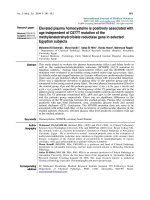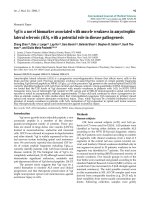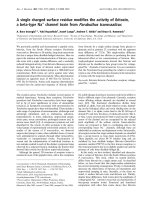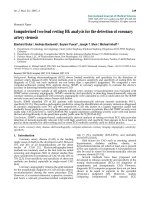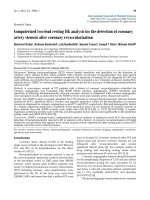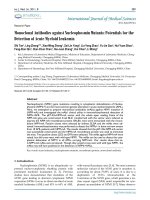Báo cáo y học: "Grb2-associated binder 1 polymorphism was associated with the risk of Helicobactor pylori infection and gastric atrophy"
Bạn đang xem bản rút gọn của tài liệu. Xem và tải ngay bản đầy đủ của tài liệu tại đây (442.21 KB, 6 trang )
Int. J. Med. Sci. 2007, 4
1
International Journal of Medical Sciences
ISSN 1449-1907 www.medsci.org 2007 4(1):1-6
© Ivyspring International Publisher. All rights reserved
Research Paper
Grb2-associated binder 1 polymorphism was associated with the risk of
Helicobactor pylori infection and gastric atrophy
Yasuyuki Goto
1
, Takafumi Ando
2
, Kazuko Nishio
1
, Sayo Kawai
1
, Yoshiko Ishida
1
, Mariko Naito
1
, Hidemi
Goto
2
, Nobuyuki Hamajima
1
1. Department of Preventive Medicine / Biostatistics and Medical Decision Making, Nagoya University Graduate School of
Medicine, Nagoya 466-8550, Japan
2. Department of Gastroenterology, Nagoya University Graduate School of Medicine, Nagoya 466-8550, Japan
Correspondence to: Yasuyuki Goto M.D., Ph.D., Department of Preventive Medicine / Biostatistics and Medical Decision Making, Nagoya
University Graduate School of Medicine, 65 Tsurumai-cho, Showa-ku, Nagoya 466-8550 Japan. Tel: +81-52-744-2133, Fax:
+81-52-744-2971, e-mail:
Received: 2006.09.22; Accepted: 2006.10.25; Published: 2006.11.01
Background: Various single nucleotide polymorphisms (SNPs) have explained the association between
Helicobacter pylori (H. pylori) and gastric atrophy and cancer. This study investigated the associations of Grb2
associated binder 1 (Gab1) polymorphism and the combination of PTPN11 gene encoding src homology 2
domain-containing protein tyrosine phosphatase-2 (SHP2) and Gab1 gene with gastric cancer and gastric atrophy
among H. pylori seropositive subjects.
Methods: A single nucleotide polymorphism at intron 2 of Gab1 (JST164345) was examined for 454 Japanese
health checkup examinees (126 males and 328 females) aged 35 to 85 without a history of gastric cancer and 202
gastric cancer patients (134 males and 68 females) aged 33 to 94 with pathologically confirmed diagnosis of
gastric adenocarcinoma.
Results: The decreased OR of the Gab1 A/A for H. pylori seropositivity was 0.25 (95% confidence interval (CI):
0.08-0.71). Among seropositive healthy controls, the OR of the Gab1 G/A+A/A for gastric atrophy was
significant (OR=1.95, 95% CI: 1.12 -3.40). Seropositive individuals with PTPN11 G/G and Gab1 G/A+A/A
demonstrated the highest risk of gastric atrophy with significance (OR=3.49, 95% CI: 1.54-7.90) relative to
PTPN11 G/A+A/A and Gab1 G/G, the lowest risk combination, as a reference. However, the gene-gene
interaction between PTPN11 and Gab1 was not observed (OR=1.39, 95% CI: 0.41-4.66). Compared to gastric cancer
case, the Gab1 did not influence the step of atrophy/metaplasia-gastric cancer sequence.
Conclusions: This study represents that the Gab1 polymorphism was associated with the low risk of H. pylori
infection and the high risk of gastric atrophy among seropositive healthy controls, and that seropositive
individuals with PTPN11 G/G and Gab1 G/A+G/G were associated with the greatest risk of gastric atrophy.
These findings require confirmation in much larger studies.
Key words: Gab1, SHP-2, Polymorphism, Gastric atrophy, Helicobacter pylori infection
1. Introduction
Gastric cancer is the fourth most frequent cancer
in the world, accounting for a large proportion of
cancer cases in East Asia (China, Japan), Eastern
Europe, and parts of Central and South America and it
is the second most common cause of death from cancer
[1]. Helicobacter pylori (H. pylori) strains carrying the
cytotoxin-associated gene A (cagA) gene are strongly
associated with increased risk of gastric
adenocarcinoma [2]. However, only some of those
infected developed H. pylori-related disease such as
gastric ulcer, atrophy, cancer and so on. In Asian
countries such as Japan with high prevalence of
cagA-positive H. pylori infection, bacterial virulence
factor has limitation of determining H. pylori-related
disease. Therefore, we think it important to determine
any host genetic predisposition to different outcome
after the bacteria infection.
H. pylori, especially cagA positive strains, plays a
crucial role in the development of gastric atrophy and
cancer [2,3]. CagA/ src homology 2 domain-containing
protein tyrosine phosphatase-2 (SHP-2) interaction
elicits cellular changes that increase the risk of
carcinogenesis via extracellular-regulated protein
kinase (ERK) activity [4,5]. CagA is regarded as a
bacterial protein that mimics mammalian
docking/scaffolding molecule such as Grb2-associated
binder 1 (Gab1)
[6].
Gab1 consists of a pleckstrin homology domain,
followed by a proline-rich region and multiple
tyrosine phosphorylation sites that serve as binding
sites for the SH2 domains of PI3-kinase, phospholipase
Cγ, SHP2, and CrkL [7,8]. Gab1 functions upstream of
Ras/mitogen-activated proten kinase (MAPK)
signaling pathway, most likely to regulate the activity
of the GDP / GTP exchanger, in a variety of growth
Int. J. Med. Sci. 2007, 4
2
receptor signaling to activate ERK. SHP-2 is a
ubiquitously expressed protein tyrosine phosphatase
(PTPase) that contains two SH2 domains and an active
catalytic domain [9,10]. SHP-2 PTPase activity is
required for activation of the ERK subfamily of MAPK
by epidermal growth factor (EGF) [11,12]. The
previous reports suggest that the interaction between
Gab1 and SHP2 is an essential component for ERK
activation [13-17]. The activated SHP-2 is associated
with Gab1 to mediate EGF-stimulated ERK2 activation,
and Gab1 is the SHP-2 activator for the ERK MAP
kinase pathway in EGF-stimulated cells [17].
We have reported previously that G/G of the
PTPN11 gene encoding SHP-2 increased the risk of
gastric atrophy among the seropositive subjects [18].
The present study examined the association of a
polymorphism of Gab1 with gastric cancer and gastric
atrophy identified as the precursor lesion of
gastric cancer amongr the same Japanese subjects.
There have been several SNPs identified in Gab1 gene
in the Japan Single Nucleotide Polymorphisms (JSNP)
database (
). A
particularly prevalent SNP is reported in intron 2
(G/A), identified as JST164345 in JSNP database. The
gene-gene interaction between PTPN11 and Gab1 was
also evaluated.
2. Materials and methods
Patients
The clinical characteristics of the subjects were
described in our previous paper [18]. Briefly, the
control group was 454 health checkup examinees
(HCE) without a history of cancer (126 males and 328
females) aged 35 to 85, who attended a health checkup
program supported by the Nagoya municipal
government, in August and September 2000. The
study protocol was approved by the Ethics Committee
of the Aichi Cancer Center, with which the chief
investigation (N.H.) was affiliated at the enrollment of
study subjects. The case group was 202 patients (134
males and 68 females) aged 33 to 94 with
pathologically confirmed diagnosis of gastric
adenocarcinoma, who underwent tumor resection in
different affiliated hospitals of Nagoya University
between January 1998 and June 2000. Informed
consent was obtained from all the subjects. This study
protocol was approved by the Ethics Committee of the
Nagoya University Graduate School of Medicine.
Tests for Helicobacer pylori (H. pylori) antibody and
pepsinogens
Anti-H. pylori IgG antibody tests, high-molecular-
weight campylobacter-associated-protein (HM-CAP)
ELISA (Enteric Products Inc., Westbury, NY) and
HM-CAP with antigens extracted from clinically
isolated Japanese H. pylori strains (J-HM-CAP) ELISA
(Kyowa Medex, Tokyo, Japan), were used for the
identification of H. pylori-infected participants (in the
control group the former was used and in the case
group both were used.). An ELISA value of 2.3 or over
was regarded as positive for both tests. The infection
was confirmed in all gastric cancer cases by culture
and bacteriological tests (Gram-negative, oxidase,
catalase, and urease test–positive spiral, curved rods)
using biopsy specimens before gastric resection.
Pepsinogens I and II (PG I and PG II) in serum were
measured by radioimmunoassay using a
commercially available kit (DINABOT, Tokyo, Japan).
Gastric atrophy was defined as PG I< 70 ng/ml and
PG I/PG II ratio <3.
Genotype Assessment
DNA was extracted from buffy coat fraction by
Qiagen QIAamp DNA Blood Mini Kit (QIAGEN
Inc.,Valencia,CA). A single nucleotide polymorphism
(SNP) at intron 2 of Gab1, named as JST164345 in a
database of Japan Single Nucleotide Polymorphisms
(JSNP) at , was
genotyped by PCR-CTPP (polymerase chain reaction
with confronting two-pair primers)
[19]. The primers
were F1: 5’ GGT TTA AAC TTT ATT CTG ACT GTT
CCC, R1: 5’ ACA CAA TTT AGT AAT AGC CAA
AGT CAA C, F2: 5’ GTT GTT GTG AAG TAG AAA
CTG ATT TCT AA, and R2: 5’ CTG GGG AGT GGG
CCA. Genomic DNA was applied in a volume of 25 ul
with 0.12 mM dNTPs, 25 pmol of each primer, 0.5
units of AmpliTaq Gold (Perkin-Elmer Corp., Foster
City, CA), and 2.5 ul 10xPCR buffer including 15mM
MgCl2. The PCR was performed with initial
denaturation at 95 ℃ for 10 minutes, followed by
30cycles of denaturation at 95 ℃ for 1 minute,
annealing at 63.5 ℃ for 1 minute and extension at 72
℃ for 5 minutes. The final extension was at 72 ℃ for
5 minutes. Figure 1 shows the results of PCR-CTPP for
Gab1. PCR product was visualized on a 2% agarose gel
with ethidium bromide staining. A SNP of PTPN11
that encodes SHP-2 (JST057927) was genotyped as
reported in our previous report [19].
Figure 1 2% agarose gel showing the different genotypes for the Gab1 polymorphism.
Int. J. Med. Sci. 2007, 4
3
Statistical analysis
To prevent confounding bias, odds ratios (ORs)
adjusted for sex and age with 95% confidence
intervals (CIs) were calculated using logistic
regression analysis.
The Hardy- Weinberg equilibrium was examined
for discrepancy between genotype and allele
distributions using a χ² test.
The product variable between gene and gene was
included in the logistic model to evaluate the
multiplicative interactive effect of genes. All tests were
2-tailed with statistical significance setting at the level
of p<0.05. Hardy-Weinberg equilibrium was tested for
the Gab1 polymorphism. These calculations were
performed by computer program STATA Version 8
(STATA Corp, College Station, TX).
3. Results
Study characteristics
Although these summary has been described
previously [18], it is shown here again for the readers’
convenience (Table 1). The prevalence of H. pylori
seropositivity was significantly higher in the gastric
cancer cases than in the healthy controls (100% vs.
55.1%, p<0.001). One hundred seventy-nine of the 202
(89%) gastric cancer cases had atrophy with
significantly higher prevalence than the control group
(35%). Atrophy was present in 54.8% of the 250 H.
pylori seropositive healthy controls, which was
significantly lower than the seropositive gastric cancer
cases (p=0.001) but significantly higher than the
seronegative healthy controls in which atrophy was
present in only 10% of subjects (p<0.001).
Table 1 Characteristics of the study subjects by source of
recruitment.
Cases
n(%)
Controls
n(%)
Number of subjects 202 454
Age in years
(mean±standard
deviation)
66.7±12.3 58.4±11.9
Sex
Male 134 (66.3) 126 (27.8)
Female 68 (33.7) 328 (72.3)
H. pylori antibody
Negative 0 (0) 204 (44.9)
Positive 202 (100) 250 (55.1)
Gastric atrophy
Negative 23 (11.4) 296 (65.2)
Positive 179 (88.6) 158 (34.8)
Gab1 polymophism and H. pylori infection risk
The Gab1 genotype distribution of the control
group was in the Hardy-Weinberg equilibrium
(χ²=2.50, P=0.11). Table 2 shows that the genotype
frequency and odds ratio (OR) of H. pylori
seropositivity in healthy controls. The seropositivity
rate for those with A/A was lowest. The decreased
OR of A/A for H. pylori seropositivity was 0.25 (95%
CI: 0.08-0.71). Twenty-one of the 204 seronegative
healthy controls (10%) had atrophy, which were
considered as the loss of H. pylori infection following
sever atrophy. To ascertain whether the reduced
infection risk related to this polymorphism follows
sever atrophy, we arranged category so as to classify
21 seronegative controls with atrophy as seropositive
controls. We calculated the OR for H. pylori again and
the corresponding OR was also a decreased risk with
significance (OR=0.25, 95% CI: 0.09-0.71).
Table 2 Genotype frequency and odds ratios (ORs) and 95%
confidence intervals (95%CIs) of H. pylori Seropositivity
(HP+) in Healthy Checkup Examinees.
Genotype n HP+ (%) OR
a
(95%CI)
G/G 317 171 (53.9) 1.00 (Reference)
G/A 119 74 (62.2) 1.30 (0.81-2.07)
A/A 18 5 (27.8) 0.25 (0.08-0.71)
G/A+A/A 137 79 (57.7) 1.02 (0.67-1.56)
a
Sex-age-adjusted odds ratio
The combination of Gab1 and PTPN11and H.
pylori-related gastric atrophy
We have got subjects narrowed down to H. pylori
seropositive healthy controls because of our interest in
the association between these polymorphisms and
digestive disease caused by H. pylori infection. We
have reported previously that G/G of the PTPN11 gene
encoding SHP-2 increased the risk of gastric atrophy
[18]. Table 3 shows the age-sex-adjusted ORs of the
Gab1 and the combinations of PTPN11 and Gab1
genotypes for gastric atrophy among seropositive
healthy controls. The OR of G/A+A/A for gastric
atrophy was significant (OR=1.95, 95% CI 1.12 -3.40).
Seropositive individuals with the PTPN11 G/G and
Gab1 G/A+A/A demonstrated the highest risk of
gastric atrophy with significance relative to PTPN11
G/A+A/A and Gab1 G/G, the lowest risk
combination, as a reference. However, the gene-gene
interaction between the PTPN11and the Gab1 was not
observed (OR=1.39, 95% CI 0.41-4.66).
Table 3 ORs and 95% CIs for gastric atrophy (GA) of Gab1
and the combinations of PTPN11 and Gab1 genotypes
among seropositive healthy controls.
Genotype n GA (%) OR
a
(95%CI)
Gab1
G/G 171 85 (49.7) 1.00 (Reference)
G/A 74 48 (64.9) 1.87 (1.06-3.29)
A/A 5 4 (80.0) 4.24 (0.45-39.7)
G/A+A/A 79 52 (65.8) 1.95 (1.12-3.40)
Total 250 137 (54.8)
PTPN11
b
Gab1
G/A+A/A G/G 49 20 (40.8) 1.00 (Reference)
G/A+A/A G/A+A/A 23 12 (52.2) 1.57 (0.58-4.29)
G/G G/G 121 64 (52.9) 1.60 (0.82-3.15)
G/G G/A+A/A 55 39 (70.9) 3.49 (1.54-7.90)
Total 248 135 (54.4)
a
Sex-age-adjusted odds ratio
b
Two subjects could not be genotyped for PTPN11
Gab1 polymorphism and the step of
atrophy/metaplasia-gastric cancer
We assessed whether the Gab1 gene
polymorphism was associated with the development
of H. pylori-related gastric cancer. Table 4 shows the
Int. J. Med. Sci. 2007, 4
4
genotype frequency and ORs of the Gab1 genotypes
for gastric cancer among the seropositive subjects. The
Gab1 gene was not associated with the risk of gastric
cancer among the seropositive subjects. In order to
find out if the Gab1 polymorphism influenced the step
of atrophy/metaplasia-gastric cancer sequence,
proposed as the Correa cascade [20], we made a
comparison between cases and controls with
seropositive atrophy. The ORs of the G/A and A/A
for gastric cancer was 1.05 (95% CI 0.63-1.74) and 1.05
(95% CI 0.27-4.07), respectively.
Table 4 The Gab1 genotype frequency and ORs for gastric
cancer among the seropositive subjects.
Genotype Cases
n
Controls
n
OR
a
(95%CI)
G/G 119 171 1.00 (Reference)
G/A 75 74 1.35 (0.88- 2.07)
A/A 8 5 1.53 (0.46- 5.10)
G/A+A/A 83 79 1.36 (0.90-2.06)
Total 202 250
a
Sex-age-adjusted odds ratio
4. Discussion
This epidemiologic finding that the Gab1
polymorphism was associated with H. pylori
seropositivity and gastric atrophy is plausible.
However, the Gab1 polymorphism did not influence
the development of gastric cancer.
The Gab1 A/A decreased the risk of H. pylori
seropositivity, whereas the Gab1 G/A+A/A was
associated with gastric atrophy risk. In order to find
out if the Gab1 polymorphism relates to loss of H.
pylori infection following severe atrophy, which has
been reported [21], we classified 21 seronegative
controls with atrophy, which might be eradicated
naturally, as seropositive controls. If the decreased OR
for H. pylori seropositivity under this condition is not
significant, we could conclude that the Gab1
polymorphism is associated with severe atrophy
which induces the chance of natural eradication of the
bacteria. However, the OR of the A/A genotype for H.
pylori seropositivity was 0.25 (95% CI 0.09-0.71). So,
the Gab1 polymorphism was associated with the low
risk of the infection independent on severe atrophy.
Although the Gab1 polymorphism prevented H. pylori
infection, it was associated with the risk of atrophy
identified as the precursor lesion of gastric cancer but
not severe atrophy which is a final stage of atrophic
status and loses H. pylori infection. Gab1 plays
important roles in the signal transduction of cytokines,
growth factors, antigen receptors [22]. The association
between the polymorphism of cytokine genes such as
interleukin 1B [23,24] and tumor necrosis factor A [25,26]
and H. pylori seropositivity have been reported. Gab1
may affect the H. pylori infection through the level of
cytokines which are advantageous to eradication of H.
pylori.
These results should be interpreted with caution.
The question is whether these apparently H.
pylori-negative subjects were indeed truly negative or
they eventually led to loss of the infection due to sever
gastric atrophy. Because, in our study, gastric atrophy
and H. pylori infection were based on serological
diagnosis and the diagnosis happened to be imperfect,
we might not discriminate severe atrophy exactly and
further biological studies with histological assessment
are needed to confirm the association. The functional
changes caused by Gab1 polymorphism are not known
and may be linkage disequilibrium with another gene.
These are deficiencies of this study but we hope that
our epidemiological and biologically plausible
observation would stimulate interest in the study of
the molecular mechanisms of action of this
polymorphism. Because these results were based on
the low frequency of A/A
, they might be inconsistent
due to the random errors. Studies of a larger size are
needed to confirm our finding. This study, however,
had 80% power to detect an absolute difference in the
frequency of G/A+A/A, given 44% in the case and
56% in the control.
The PTPN11 polymorphism was associated with
gastric atrophy among seropositive subjects [18].
The
two tyrosine residues (Tyr-627 and Tyr-659) in the
carboxyl-terminal region of Gab1 are required for
SHP-2 binding to Gab1 and for EGF-stimulated ERK
activation, in which another study reported
Gab1/SHP-2 interaction was independent of ERK
activation [27]. Tyr-627 and Tyr-659 of Gab1 constitute
a bisphosphoryl tyrosine-based activation motif
(BTAM) that binds to and activates SHP-2 [17]. Two
SH2 domaines of SHP-2, termed N-SH2 and C-SH2
domaines, are arranged in tandem at the amino
(N)-terminal portion. SHP-2 has a low basal PTPase
activity that can be activated by deletion of N-SH2 or
both SH2 domains or by specific phosphopeptides
that bind to the SH2 domains. The tandem SH2
domains bind to Tyr-627 and Tyr-659 simultaneously
in a specific orientation, in which Tyr-627 binds to the
N-SH2 domain and Tyr-659 binds to the C-SH2
domain [17]. Experiments with Gab1 mutants which
are unable to bind to SHP-2 indicate that the
interaction between SHP-2 and Gab1 and the
activation of SHP-2 are essential for ERK activation
[28-30]. The Gab1 polymorphism may affect the
interaction with SHP-2 through the mechanism such
as BTAM after H pylori infection, resulting in
influencing the abnormal proliferation and movement
of gastric epithelial cells related to gastric atrophy via
the activation of ERK.
This study also showed that the gastric atrophy
risk was highest for those who carry the PTPN11 G/G
and Gab1 G/A+A/A among seropositive subjects
without interaction between those genotypes.
Considering the mechanism such as BTAM, the
epidemiologic interaction was expected, but not
observed.
Among the seropositive subjects, the Gab1
polymorphism was not associated with gastric cancer.
When we made a comparison between cases and
controls with seropositive atrophy, the ORs of G/A
and A/A for gastric cancer were also each
insignificant. This result showed that this
Int. J. Med. Sci. 2007, 4
5
polymorphism did not influence the step of
atrophy/metaplasia-gastric cancer sequence. As
discussed in our previous report [18], our all gastric
cancer cases had evidence of H. pylori infection
because of the earlier presentation or diagnosis of
cancer.
In summary, the Gab1 A/A was associated with
the low risk of H. pylori infection while the G/A and
A/A genotypes together may increase the risk for
gastric atrophy. The biological mechanism of this
polymorphism remains to be elucidated. In addition,
individuals with the PTPN11 G/G and Gab1
G/A+A/A demonstrated the greatest risk of gastric
atrophy with no interaction. Our data provided
further evidence for host genetic factors in the
susceptibility to H pylori infection and H. pylori-related
gastric atrophy. Further investigation of the
association requires much larger studies, as well as
confirmatory biological studies with histological
assessment.
Acknowledgments
The authors are grateful to Dr. Nobuyuki
Katsuda for the enrollments of controls, and Ms. Yoko
Mitsuda and Ms. Mayumi Kato for their technical
assistance. This work was supported in part by a
Grant-in-Aid for Scientific Research on Special Priority
Areas of Cancer from the Ministry of Education,
Culture, Sports, Science and Technology of Japan.
Conflicts of interest
The authors have declared that no conflict of
interest exists.
References
1. Parkin DM, Bray F, Ferlay J, Pisani P. Global cancer statistics,
2002. CA Cancer J Clin 2005; 55:74-108.
2. Blaser MJ, Perez-Perez GI, Kleanthous H, et al. Infection with
Helicobacter pylori strains possessing cagA is associated with
an increased risk of developing adenocarcinoma of the stomach.
Cancer Res 1995; 55: 2111-5.
3. Uemura N, Okamoto S, Yamamoto S, et al. Helicobacter pylori
infection and the development of gastric cancer. N Engl J Med
2001; 345: 784-9.
4. Higashi H, Tsutsumi R, Muto S, et al. SHP-2 tyrosine
phosphatase as an intracellular target of Helicobacter pylori
CagA protein. Science 2002; 295: 683-6.
5. Higashi H, Nakaya A, Tsutsumi R, et al. Helicobacter pylori
CagA induces Ras-independent morphogenetic response
through SHP-2 recruitment and activation. J Biol Chem 2004;
279: 17205-16.
6. Hatakeyama M. Helicobacter pylori CagA--a potential bacterial
oncoprotein that functionally mimics the mammalian Gab
family of adaptor proteins. Microbes Infect. 2003; 5: 143-150.
7. Hibi M, Hirano T. Gab-family adapter molecules in signal
transduction of cytokine and growth factor receptors, and T
and B cell antigen receptors. Leuk Lymphoma 2000; 37: 299-307.
8. Liu Y, Rohrschneider LR. The gift of Gab1. FEBS lett 2002; 515:
1-7.
9. Feng GS, Hui CC, Pawson T. SH2-containing phosphotyrosine
phosphatase as a target of protein-tyrosine kinases. Science
1993; 259: 1607-11.
10. Vogel W, Lammers R, Huang J, Ullrich A. Activation of a
phosphotyrosine phosphatase by tyrosine phosphorylation.
Science 1993; 259: 1611-4.
11. Deb TB, Wong L, Salomon DS, et al. A common requirement for
the catalytic activity and both SH2 domains of SHP-2 in
mitogen-activated protein (MAP) kinase activation by the ErbB
family of receptors. a specific role for SHP-2 in MAP, but not
c-Jun amino-terminal kinase activation. J Biol Chem 1998; 273:
16643-6.
12. Bennett AM, Hausdorff SF, O'Reilly AM, et al. Multiple
requirements for SHPTP2 in epidermal growth factor-mediated
cell cycle progression. Mol Cell Biol 1996; 16: 1189-202.
13. Cunnick JM, Dorsey JF, Munoz-Antonia T, et al. Requirement
of SHP2 binding to Grb2-associated binder-1 for
mitogen-activated protein kinase activation in response to
lysophosphatidic acid and epidermal growth factor. J Biol
Chem 2000; 275: 13842 – 8.
14. Ymazaki S, Nishida K, Yoshida Y, et al. Gab1 is required for
EGF receptor signaling and the transformation by activated
ErbB2. Oncogene 2003; 22: 1546-56.
15. Schaeper U, Gehring NH, Fuchs KP, et al. Coupling of Gab1 to
c-Met, Grb2, and Shp2 mediates biological responses. J Cell Biol
2000; 149: 1419-32.
16. Maroun CR, Naujokas MA, Holgado-Madruga M, et al. The
tyrosine phosphatase SHP-2 is required for sustained activation
of extracellular signal-regulated kinase. Mol Cell Biol 2000; 20:
8513-25.
17. Cunnick JM, Mei L, Doupnik CA, Wu J. Phosphotyrosines 627
and 659 of Gab1 constitute a bisphosphoryl tyrosine-based
activation motif (BTAM) conferring binding and activation of
SHP2. J Biol Chem 2001; 276: 24380-7.
18. Goto Y, Ando T, Yamamoto K, et al. Association between the
precursor lesion of gastric cancer and polymorphism of
PTPN11 encoding SHP-2 among Helicobacter pylori
seropositive Japanese. Int J Cancer. 2006; 118: 203-208.
19. Hamajima N, Saito T, Matsuo K, et al. Polymerase chain
reaction with confronting two-pair primers for polymorphism
genotyping. Jpn J Cancer Res 2000; 91: 865-68.
20. Correa P, Haenszel W, Cuello C, et al. A model for gastric
cancer epidemiology. Lancet 1975; 2: 58-9.
21. Asaka M, Sugiyama T, Nobuta A, et al. Atrophic gastritis and
intestinal metaplasia in Japan: results of a large multicenter
study. Helicobacter 2001; 6: 294-9.
22. Nishida K, Yoshida Y, Itoh M, et al. Gab-family adapter
proteins act downstream of cytokine and growth factor
receptors and T- and B-cell antigen receptors. Blood. 1999; 93:
1809-1816.
23. Hamajima N, Matsuo K, Saito T, et al. Interleukin 1
polymorphisms, lifestyle factors, and Helicobacter pylori
infection. Jpn J Cancer Res. 2001; 92: 383-9.
24. Uno M, Hamajima N, Ito LS, et al. Helicobacter pylori
seropositivity and IL-1B C-31T polymorphism among Japanese
Brazilians. Int J Mol Med. 2002; 10: 321-326.
25. Yea SS, Yang YI, Jang WH, et al. Association between
TNF-alpha promoter polymorphism and Helicobacter pylori
cagA subtype infection. J Clin Pathol. 2001; 54: 703-706.
26. Hamajima N, Shibata A, Katsuda N, et al. Subjects with
TNF-A-857TT and -1031TT genotypes showed the highest
Helicobacter pylori seropositive rate compared with those with
other genotypes. Gastric Cancer. 2003; 6: 230-236.
27. Holgado-Madruga M, Wong AJ. Role of the Grb2-associated
binder 1/SHP-2 interaction in cell growth and transformation.
Cancer Res 2004; 64: 2007-15.
28. Schaeper U, Gehring NH, Fuchs KP, et al. Coupling of Gab1 to
c-Met, Grb2, and Shp2 mediates biological responses. J Cell Biol.
2000; 149: 1419-1432.
29. Maroun CR, Naujokas MA, Park M. Membrane targeting of
Grb2-associated binder-1 (Gab1) scaffolding protein through
Src myristoylation sequence substitutes for Gab1 pleckstrin
homology domain and switches an epidermal growth factor


